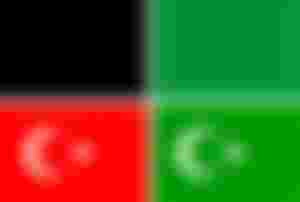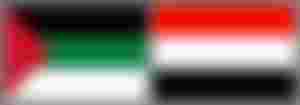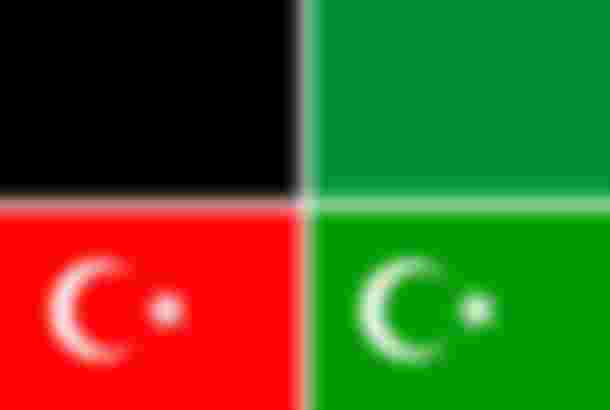As I mentioned in a previous article, strictly it is haram (forbidden) with a symbol of Islam. That doesn't mean that Muslim countries must not have symbols, although the Islamic view has influenced also political symbols of country or nationality. We have previously discussed the Turkish symbol of the Star-and-Crescent, which occur on many contemporary flags, the Eagle of Saladin, which is found in the centre of the Egyptian flag, and the Hawk of Quraish, which occurs on heraldic arms of certain present and past Muslim states. Apart from them, flags of present Muslim countries, and especially Arab countries, tend to consist only of coloured areas in black, white, green and red - although there are exceptions. The colours, however, are also symbols, and they have their roots in the history of Islam.
The Prophet Mohammed used a flag as a standard in war. Those flags where different for different campaigns, and, as far as it is known, each one was in a single colour – most notably black, white, red and green. His most important flag, however, was al-Uqāb, a black flag, originally the national flag of the Quraish, the tribe to which the Prophet belonged. Al-Uqāb could have markings, such as a bird of prey in its centre (the hawk of Quraish) - or white text.
The Rashidun Caliphs (632–661) , the four caliphs who followed immediately after the Prophet himself, also used the black flag.
There is no information about the flag of the Umayyad Caliphate (661–750), but the Umayyad Caliphate of Cordoba (929–1031) used a white flag, so one can suspect that the first Umayyad Caliphate did so as well.
The Abbasid Caliphate (750–1258, 1261–1517) used a black flag. It was not based on al-Uqāb, but on an event in the history of the Abbasids themselves. The black was a symbol they adopted when their leader was killed by the (then) Umayyad regime.
The Fatimid Caliphate (909–1171), used a green flag.
The Almohad Caliphate (1147–1269) used a white flag.
(Below: Al-Uqāb [top left], the Fatimide Flag [top right], the last flag of Ottoman Empire [bottom left], the flag of the Ottoman Caliphate [bottom right].)

With the Ottoman Caliphate (1517–1924), which was the first of Turkish nationality, a symbol other than a single colour turns up on the flag: the star-and-crescent. The Turks were also the first to separate the religious flag from the national flag, using a red background on the former and a green on the latter. However, this developed gradually. When Selim I officially became the caliph, the flag of the Ottomans was red with a green circle and three yellow crescents.
Since the 18th century Hotak dynasty, the Pashtuns in Afghanistan used a black flag with the shahada (Islamic credo) in white as a military ensign. This flag was adopted by the (Pashtu) Taliban in the 1990s, although inverted, and later various extremist groups adopted black flags with the credo.
Compare this with the modern flag of Saudi Arabia. It is green with the credo in white and a sword, representing Abd-al-Aziz.

Typical for flags of so-called Arab countries, is that they come in the colours of black, white, red and green – the same colours as I mentioned above in connection with the Prophet Mohammed. These colours have come to represent the concept of pan-Arabism. The first time they did so was on the flag of the Arab revolt against the Ottoman Turks during World War I. It became the symbol of Arab nationalism.
Here they claim that it is Abbasid black, Umayyad white, Fatimide green and that the red symbolises the Hashemite royal dynasty, which was at the centre of the revolt. Their power also peaked just after World War I. Today they rule only Jordan, but then they had also Iraq, Greater Syria, and Hijaz. Greater Syria was dissolved already 1920, Hijaz was taken by the House of Saud in 1925, and they lost Iraq in 1958.

The Flag of the Arab Revolt (left) and the Arab Liberation Flag (right) were and are the basis for the flags of a large number of Arab countries: presently Egypt, Iraq, Jordan, Kuwait, Libya, Palestine, Somaliland, Sudan, Syria, the United Arab Emirates, and Yemen. They have also been the basis of many former flags, flags of previously existing Arab countries, and flags of political or para-military organisations.
Related articles:
Saladin & The Ayyubid Dynasty - Saladin's Eagle, and Saladin's Citadel
The Crocodile, a Symbol of Egypt?
Snakes in Astrology & Heraldry
Fleur-de-lis & The Lily of Florence
La Tricolore: What is the Origin of Its Colours and Design?
The Star-And-Crescent - A Symbol for Islam?
Nisshōki, Taegeukgi & the Nordic Cross
The Eagle as an Heraldic Symbol of Empire
Copyright © 2017, 2021 Meleonymica/Mictorrani. All Rights Reserved.
Here you find my articles related to symbols, and to history.
Interested in history, legends and myths, join my community History, Myths, Legends & Mysteries (be45).
You find all my writings on Read.Cash, sorted by topic, here.



Thanks to know that you are a muslim.Me also a muslim and i have no idea about these flags.I learn many things from your article.